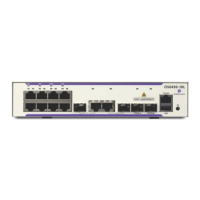Configuring VLAN Stacking Services Configuring VLAN Stacking
page 27-14 OmniSwitch AOS Release 7 Network Configuration Guide March 2011
• stp legacy-bpdu—Specifies whether or not legacy Spanning Tree BPDU are tunneled on the NNI port.
The following command example configures the vendor TPID for NNI port 2/1 to 0x88a8 and enables
support for Spanning Tree legacy BPDU:
-> ethernet-service nni port 2/1 tpid 88a8 stp legacy-bpdu enable
Consider the following when configuring NNI port parameter values:
• A mismatch of TPID values on NNI ports that are connected together is not supported; VLAN Stack-
ing will not work between switches using different NNI TPID values.
• Enable legacy BPDU support only on VLAN Stacking network ports that are connected to legacy
BPDU switches. Enabling legacy BPDU between AOS switches may cause flooding or an unstable
network.
• If legacy BPDU is enabled on a network port while at same time BPDU flooding is enabled on user
ports, make sure that tagged customer BPDUs are not interpreted by intermediate switches in the
provider network.
• If the peer switch connected to the VLAN Stacking network port supports the Provider MAC address
(i.e., STP, 802.1ad/D6.0 MAC), then enabling legacy BPDU support is not required on the network
port. Refer to the following table to determine the type of STP MAC used:
• STP legacy BPDU are supported only when the flat Spanning Tree mode is active on the switch.
• NNI ports can be 802.1q tagged with normal VLANs. The TPID of the packets tagged with the normal
VLAN is 0x8100 (regardless of the TPID of the NNI port). This allows the NNI port to carry both
802.1q tagged traffic and SVLAN tagged traffic.
• Only fixed ports can be converted to NNI ports.
Use the show ethernet-service nni command to display the NNI port configuration for the switch.
Configuring a VLAN Stacking Service Access Point
The ethernet-service sap command is used to configure a VLAN Stacking service access point (SAP). An
SAP is assigned an ID number at the time it is configured. This ID number is then associated with the
following VLAN Stacking components:
• User Network Interface (UNI) ports. See “Configuring VLAN Stacking User Ports” on page 27-15.
• Customer VLANs (CVLANs). See “Configuring the Type of Customer Traffic to Tunnel” on
page 27-16.
• SAP profile. Each SAP is associated with a single profile. This profile contains attributes that are used
to define traffic engineering parameters applied to traffic ingressing on UNI ports that are associated
with the SAP. See “Configuring a Service Access Point Profile” on page 27-17.
STP
Customer MAC {0x01, 0x80, 0xc2, 0x00, 0x00, 0x00}
Provider MAC address (802.1ad/D6.0) {0x01, 0x80, 0xc2, 0x00, 0x00, 0x08}
Provider MAC address (Legacy MAC) {0x01, 0x80, 0xc2, 0x00, 0x00, 0x00}
Provider MAC address {0x01, 0x80, 0xc2, 0x00, 0x00, 0x0D}

